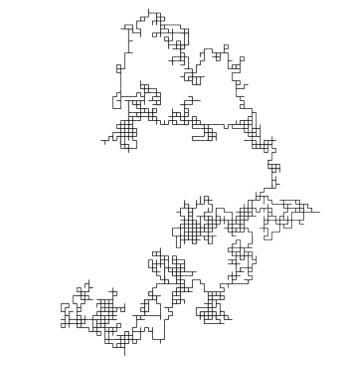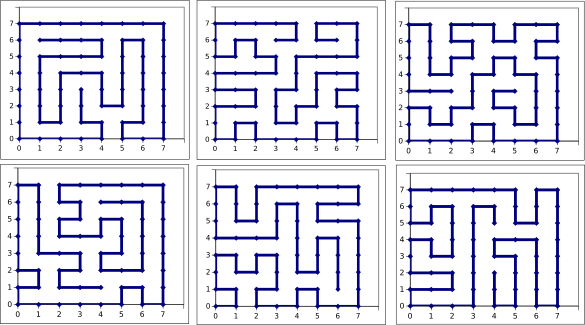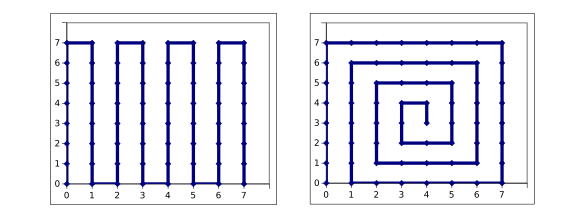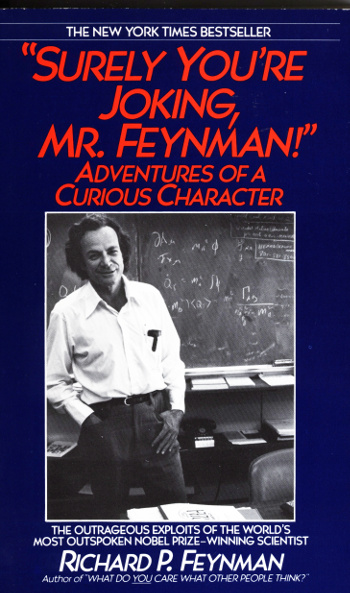Random Walks
June 17, 2023
Stumblebum is a
word from my
childhood that's not
commonly used today. Its meaning as an
alcoholic derelict began in 1932, and its
frequency of use surged in the late
1940's, around the
time of my birth, to 4
parts per billion and is now at 5 parts per billion;[1] so, if you read 200 million words, about the number of words in 2,000
novels, you'll see it just once. I've always associated stumblebum with the so-called
drunkard's walk, a type of
random walk.

These are the first few steps of a 23,000 step random walk, shown in animation by clicking the figure.
I've created a simple C language program for generating a file of the (x,y) coordinates of such a walk (source code here), and the walk is easily graphed from that file using Gnumeric or Gnuplot.
(Animated 25 000 step random walk (GIF image) by László Németh, via Wikimedia Commons available by Clicking the image.)
In the walk described above, you're allowed to step over any portion of the path created earlier. There's another type of random walk for which this path-crossing is disallowed. This walk, usually done on a
two dimensional square lattice, is the
self-avoiding random walk. It's as if you're building a
brickwall behind you as you
walk, and that wall prevents your crossing your prior path.
When I decided to implement such a walk on an 8 x 8 lattice, I discovered two things. First, there were no
C language examples; and, second, it was
conjectured that such a walk on an 8 x 8 lattice was impossible to
brute force on a
home computer. I was able to find six
full-tour walks in a few
days on my not very speedy
Linux desktop computer[2] using a C language program (
Source code here). These six solutions yield many more solutions though
reflection and
rotation operations. I also wrote an enhanced C language program that collects
statistics on the brute-force searches (Source code
here).

Six full-tour self-avoiding random walks on an 8x8 two dimensional square lattice as discovered by my C language program. (Graphed using Gnumeric. Click for larger image.)
The first example in the figure above (leftmost, top row) is not that interesting, since it has several long
straight sections. This brings us to the idea of
tortuosity, a measure of the
deviation of a path from a straight line. This is an important
parameter for
prediction of the
transport properties of
porous materials, and there are
mathematical methods for its
calculation for different cases. For our self-avoiding random walk, we can just use the
ratio of the number of
direction changes to the maximum possible number (62). The calculated tortuosities for the examples in the above figure,
clockwise from the upper leftmost, are 0.339, 0.677, 0.677, 0.484, 0.565, and 0.516.

Examples of low tortuosity paths - A zig-zag and spiral walk on an 8x8 two dimensional square lattice. In both cases, the calculated tortuosity, defined as the ratio of the number of direction changes to the maximum possible number of direction changes (62), is 0.226. (Click for larger image.)
Writing about the drunkard's walk reminds me of the
observational bias problem known as the
streetlight effect, but also called the drunkard's search
principle. This is when you only search for something where it is easiest to look. I've been
guilty of this myself in a different sense by only doing
experiments with the
chemicals I have on my
laboratory shelf. The
drunkard's search name comes from a well known
joke, given here as I first heard it.
Someone sees a drunk man searching under a street light and asks him what he's looking for. He says he dropped his car keys; so, the stranger starts searching, also. After a while, the stranger asks the drunkard if he remembers the approximate location where he dropped them. The drunkard points at a car in the distance and says, "At my car." The confused stranger asks, "Then why are you looking here?" To which the drunkard replies, "The light's better."
There are some other things in
science that relate to
alcohol. I'll lead with the
lame joke that's likely
funny only to
middle school science
students. A
neutron walks into a
bar and asks the
bartender the
price of a
drink. The bartender replies, "For you, no
charge."
An alcoholic beverage actually assisted in an
invention worthy of the
Nobel Prize in Physics.
Physicist,
Don Glaser (1926-2013) used
beer in experiments to create the
bubble chamber used in early
particle physics experiments.
Movement of
charged particles through a
liquid just below its
boiling point creates an
ionization track that
vaporizes the liquid to form
microscopic bubbles. This beer
story has been told as Glaser's being
inspired by observing a
glass of beer he was drinking, but he said that this wasn't the case.

(Scan of my copy. Click for larger image.)
Nobel Physics Laureate,
Richard Feynman (1918-1988) decided to refrain from alcohol when he realized that he might become
addicted to it.
As he wrote in his
autobiography, "
Surely you're joking, Mr. Feynman,[3] "I started to walk into the bar, and I suddenly thought to myself, "Wait a minute! It's the middle of the
afternoon. There's nobody here. There's no
social reason to drink. Why do you have such a terribly strong feeling that you have to have a drink?" - and I got scared. I never drank ever again, since then. I suppose I really wasn't in any
danger, because I found it very easy to stop. But that strong feeling that I didn't understand
frightened me. You see, I get such
fun out of
thinking that I don't want to destroy this most
pleasant machine that makes
life such a big
kick."
References:
- Stumblebum (n.) at etymonline.com.
- My somewhat old desktop computer has an Intel dual core i3-4160 64-bit CPU running at 3.6 GHz with 8 GB of memory. The Linux operating system runs the 5.15.0-73-generic x86_64 kernel with a Cinnamon 5.4.12 desktop on Linux Mint 21.
- Richard P. Feynman and Ralph Leighton, "Surely You're Joking, Mr. Feynman!": Adventures of a Curious Character, W. W. Norton & Company; Reissue edition (February 6, 2018), Paperback, 400 pp., ISBN: 978-0393355628 (via Amazon).
Linked Keywords: Stumblebum; word; childhood; parlance; commonly used; statistical frequency; 1940's; baby boomer; parts-per notationvparts per billion; novel; drunkard's walk; random walk; walking; step; animation; C language program; computer file; Cartesian coordinate system; (x,y) coordinates; source code; random walk unbounded.c; graph; Gnumeric; Gnuplot; GIF image; László Németh; Wikimedia Commons; two-dimensional space; lattice graph; square lattice; self-avoiding random walk; brick; wall; conjecture; brute-force attack; home computer; full-tour; day; Linux; desktop computer; sa walk.c; reflection symmetry; rotational symmetry; operation (mathematics); statistics; sa walk stats.c; six full-tour self-avoiding random walks on an 8x8 lattice; Gnumeric; line (geometry); straight; tortuosity; deviation (statistics); parameter; prediction; transport phenomena; transport property; porosity; porous; material; mathematical model; mathematical method; calculation; ratio; direction (geometry); clockwise; a zig-zag and spiral walk on an 8x8 lattice; zig-zag; spiral; observation in science; cognitive bias; streetlight effect; principle; guilt (emotion); guilty; experiment; chemical compound; laboratory; shelf (storage); joke; search; street light; automobile; car; key; stranger; approximation; approximate location; confusion; confused; lighting; light; science; alcoholic beverage; lame; humor; funny; middle school; student; neutron; bar (establishment); bartender; price; cost; charge; invention; Nobel Prize in Physics; physicist; Don Glaser (1926-2013); beer; bubble chamber; subatomic particle; particle physics; motion (physics); movement; electric charge; charged; elementary particle; liquid; boiling point; ionization; track; vaporization; vaporize; microscopic scale; liquid bubble; narrative; story; eureka effect; inspired; glassware; glass; Surely you're joking, Mr. Feynman; Nobel Physics Laureate; Richard Feynman (1918-1988); addiction; addicted; autobiography; afternoon; society; social; convention (norm); reason; risk; danger; fear; frighten; amusement; fun; contemplation; thinking; pleasure; pleasant; machine; life; happiness; kick.